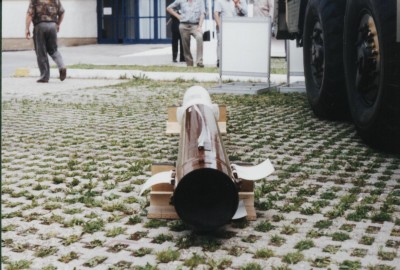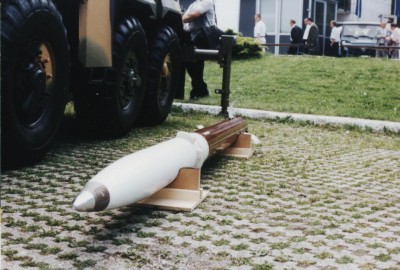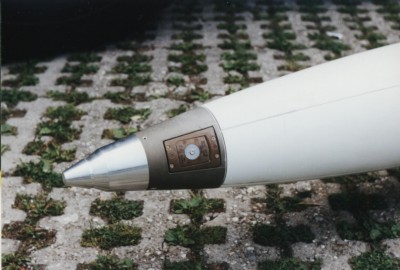M26
Directed cluster reactive ammunition of 227 mm calibre. The missile flies along a ballistic curve stabilized by ailerons, and contains 644 pieces of M77 multi-purpose submunitions (effective against infantry and lightly armored targets). The submunition, encased in special polyurethane foam, is released above the target (at medium altitude), is stabilized by fabric bands during free fall, and explodes on impact. The first operational use of the missile is documented during Operation Desert Storm in 1991, where it earned its nickname "Steel Rain".
The protection of the missile from environmental effects during storage and transport is provided by a container that houses a total of 6 missiles in launchers.The reloading of the launcher is done by exchanging the entire container (empty for full). The rocket is stored in the container in a separate launcher, in which it is hermetically sealed and from where the actual launching takes place.
A distinct disadvantage of this rocket is that the submunition used has a relatively high probability of failure (over 5% of submunitions have failed in tests), which poses a risk when moving in the area where this munition was used (unexploded but defused M77 shells).
The rocket has a standard design with stabilizers in the rear. Towards the rear there is a launcher motor, a solid propellant rocket flight engine, a warhead with submunitions, and an M445 fuze.
Basic tactical and technical data:
Caliber: 227 mm
Length: 3900 mm
Range: 11,500 - 32,000 m
Weight: 306 kg
Area hit by salvo: 0.23 km2
Manufacturer: Lockheed Martin (Vought)
Versions:
M26A1 - version with range extended to 45 km at the expense of the amount of submunitions (518 pieces). For this missile a new M85 submunition was developed with a reduced chance of failure (below 1%), since 1999 a total of about 1200 missiles have been produced for US needs.
M26A2 - version with range extended at the expense of the amount of submunition (518 pcs), which is made up of M77 grenades due to the delay indevelopment of the 85 submunition. In production from July 1996 (07/1996) until 1999 (when it was replaced in production by the M26A1 missile with the more reliable M85 submunition). A total of about 3100 missiles produced.
M28 - a trainer version of the missile designed for training (in firing). It has identical ballistic characteristics to the M26 combat missile, but the warhead replaces the submunition with ballast and a trio of aerosol containers that mimic the submunition's burst in the target area for hit identification.
Use:
M270 MLRS (12 missiles in a pair of containers)
M142 HIMARS (6 missiles in one container)
RM-70 Modular (6 missiles in one container)
RM-70/85 Modular (6 missiles in one container)
The munition is subject to a ban under the Convention on Cluster Munitions Ban and is being phased out of the arsenals of most states, that have acceded to the Convention.
Users:
Source: author archive
Directed cluster reactive ammunition of 227 mm calibre. The missile flies along a ballistic curve stabilized by ailerons, and contains 644 pieces of M77 multi-purpose submunitions (effective against infantry and lightly armored targets). The submunition, encased in special polyurethane foam, is released above the target (at medium altitude), is stabilized by fabric bands during free fall, and explodes on impact. The first operational use of the missile is documented during Operation Desert Storm in 1991, where it earned its nickname "Steel Rain".
The protection of the missile from environmental effects during storage and transport is provided by a container that houses a total of 6 missiles in launchers.The reloading of the launcher is done by exchanging the entire container (empty for full). The rocket is stored in the container in a separate launcher, in which it is hermetically sealed and from where the actual launching takes place.
A distinct disadvantage of this rocket is that the submunition used has a relatively high probability of failure (over 5% of submunitions have failed in tests), which poses a risk when moving in the area where this munition was used (unexploded but defused M77 shells).
The rocket has a standard design with stabilizers in the rear. Towards the rear there is a launcher motor, a solid propellant rocket flight engine, a warhead with submunitions, and an M445 fuze.
Basic tactical and technical data:
Caliber: 227 mm
Length: 3900 mm
Range: 11,500 - 32,000 m
Weight: 306 kg
Area hit by salvo: 0.23 km2
Manufacturer: Lockheed Martin (Vought)
Versions:
M26A1 - version with range extended to 45 km at the expense of the amount of submunitions (518 pieces). For this missile a new M85 submunition was developed with a reduced chance of failure (below 1%), since 1999 a total of about 1200 missiles have been produced for US needs.
M26A2 - version with range extended at the expense of the amount of submunition (518 pcs), which is made up of M77 grenades due to the delay indevelopment of the 85 submunition. In production from July 1996 (07/1996) until 1999 (when it was replaced in production by the M26A1 missile with the more reliable M85 submunition). A total of about 3100 missiles produced.
M28 - a trainer version of the missile designed for training (in firing). It has identical ballistic characteristics to the M26 combat missile, but the warhead replaces the submunition with ballast and a trio of aerosol containers that mimic the submunition's burst in the target area for hit identification.
Use:
M270 MLRS (12 missiles in a pair of containers)
M142 HIMARS (6 missiles in one container)
RM-70 Modular (6 missiles in one container)
RM-70/85 Modular (6 missiles in one container)
The munition is subject to a ban under the Convention on Cluster Munitions Ban and is being phased out of the arsenals of most states, that have acceded to the Convention.
Users:


